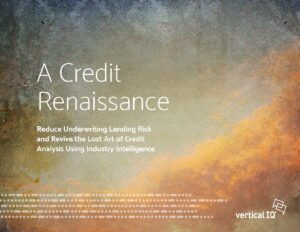Our eBook, A Credit Renaissance: Reduce Underwriting Lending Risk and Revive the Lost Art of Credit Analysis Using Industry Intelligence, is available now! The eBook examines how Industry Intelligence bolsters credit underwriting and analysis and improves the lending process. This blog series highlights concepts within the eBook on a high level, with more in-depth insights found in the eBook itself. This is the first entry in this four-part series.

Credit lending is a primary component of most financial institutions’ business model, and loans are the largest asset on the bank’s balance sheet. Banks and credit unions rely on the interest income from their loans to meet their own financial obligations. Therefore, it is mission critical that they ensure they are making good lending decisions — only extending credit to established businesses with sufficient recurring cash flow and a sound financial condition that enables them to repay their debts in full and on time.
So what can you do to ensure your credit analysis is top-notch? Credit training is essential — bankers aren’t born with this knowledge or these skills; a master of their craft must teach them via a modern-day form of apprenticeship: an effective credit training program.
Achieving growth
According to the Statista Research Department, the total value of commercial and industrial loans in the U.S. is over $2.7 trillion — up more than $2 trillion over the past 30 years. Needless to say, commercial and industrial lending has become a critical growth segment for banks.
So, which businesses are worth your investment? This is where effective, thorough credit analysis comes in. When analyzing a loan, you need to understand a business’s sources and uses of cash, as well as financial statements, including the balance sheet, income statement, and cash flows. A strong analysis ensures sound deals get closed (won) more often, which in turn, protects and grows the bank’s assets. It also demonstrates that the bank understands the business’s industry and its credit needs.
Growth and Protection
Banking is a risky industry; worse than a loan going into default is a loan defaulting because of a lack of oversight. With businesses operating in so many industries, bankers and their credit partners need help. Bankers shepherd credit deals from start to finish — they are the business owners’ advocates. At their core, credit analysts have two key functions: protect and grow the bank’s assets. So what does this mean?
A good loan boils down to two things:
-
- A company borrowing from a bank in “sound financial condition.”
- The money coming back to the bank in “good condition.”
To be assured that you have underwritten a good loan, our eBook takes a deeper look at some familiar (and not-so-familiar) methods of credit analysis, including thin-slicing, spreading, projections, turn analysis, risk rating analysis, and more. These methods are enhanced by combining effective credit training and a powerful solution for your industry-specific needs.
The Power of Credit Training and Industry Intelligence
Masterful credit training and an all-encompassing solution like Vertical IQ are essential to address gaps in industry knowledge. With both, you can better understand company financials and needs.
A Credit Renaissance was written with both in mind: It features valuable insights on top-tier methods of credit analysis from David Nicholson, founder of Credit Training, Inc., and it examines how Industry Intelligence from Vertical IQ can help provide you with critical, in-depth industry content to paint a better picture of your prospect’s credit needs.
Together, credit training and Industry Intelligence put you in a position to make the best possible lending decisions — ultimately helping you drive growth for your bank!
>> Want to master the art of credit analysis using Industry Intelligence? Download A Credit Renaissance: Reduce Underwriting Lending Risk and Revive the Lost Art of Credit Analysis Using Industry Intelligence to learn more!
Image credit: Vertical IQ